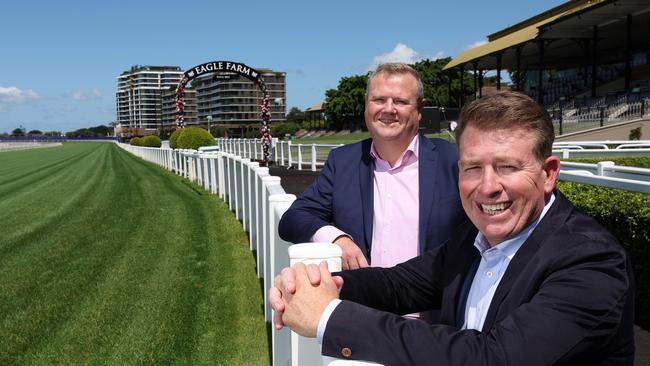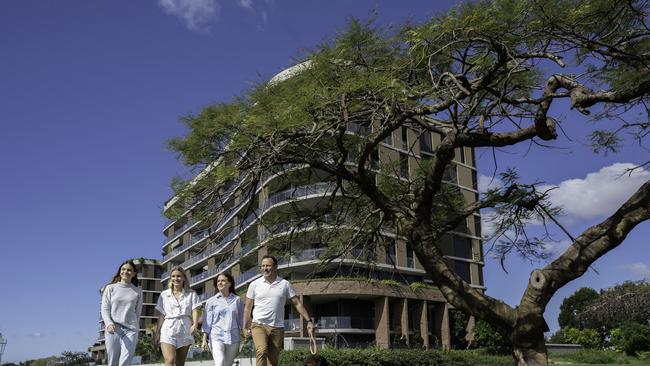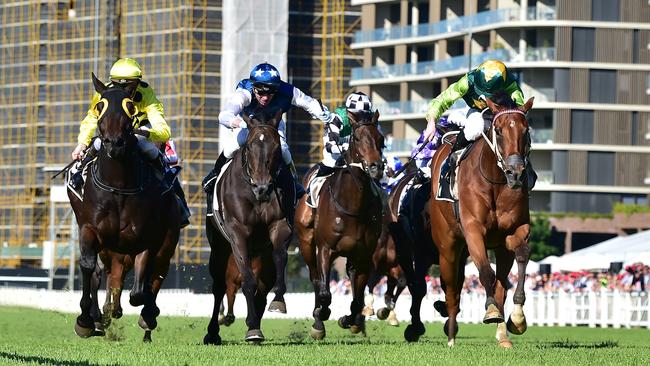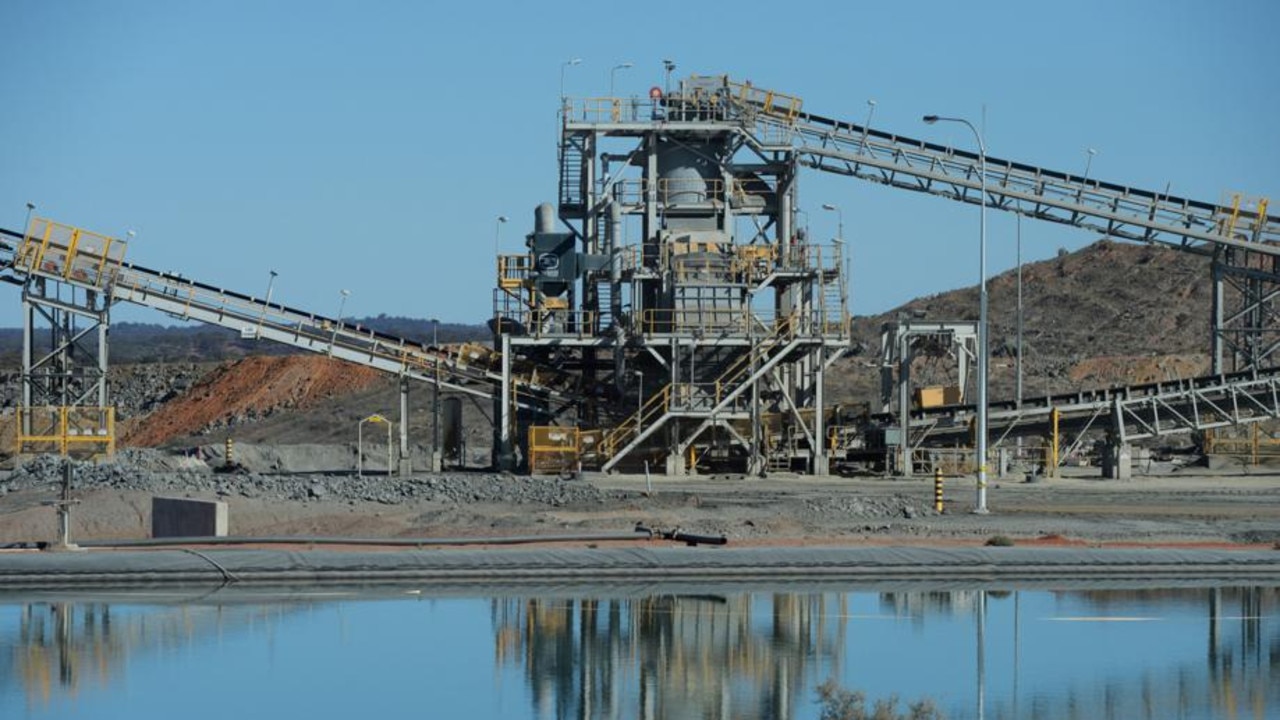The Brisbane Racing Club is halfway through its $1.5bn master plan to survive
After a historic merger 15 years ago the Brisbane Racing Club is halfway through its blueprint for survival and while they are hitting their stride the race is far from over.

Business
Don't miss out on the headlines from Business. Followed categories will be added to My News.
Almost 15 years ago Brisbane’s two thoroughbred racing clubs in the eastern suburbs cast aside decades of rivalry and joined forces.
Both clubs were land rich but cash poor with dwindling revenues, and the Brisbane Racing Club was formed on July 1, 2009, from the merger of the neighbouring Queensland Turf Club at Eagle Farm and the Brisbane Turf Club at the Doomben Racecourse in Ascot.
A long-term plan to preserve the racecourses was formulated and an ambitious $1.5bn masterplan was launched in 2012 to develop up to 19ha of excess land and diversify its income streams.
New chairman Richard Morrison, who recently took over from Neville Bell who had launched the masterplan, said that in terms of area they were about halfway through their development strategy.
“What the masterplan does is identify the areas for core racing that will never be touched,” said Mr Morrison whose 4000-member owned club runs Queensland’s most famous race, the Star Stradbroke Handicap.
“They need to be retained and enhanced to promote thoroughbred racing. We’re a race club – we host about 80 races a year – and that’s our number one priority.
“But the plan also identified the pieces of real estate that could potentially have other uses.
There’s still plenty of work that needs to be done but were doing well.”
Over the past decade the BRC has developed the $50m Eagle Farm Infield Stabling and Training Facilities, two Ascot Green residential towers, Racecourse Village Shopping Centre, Ascot Childcare and Kindy, Bernborough Ascot Retirement Living and the Ascot Aquatic Centre.
This year they should complete Charlton House – the third residential tower at Ascot Green they are developing with Mirvac. There are another five buildings to be constructed.
The BRC has also diversified into licensed clubs and investment bringing dilapidated venues back to life and they now operate Gallopers Sports Club at Ascot, Souths Sports Club at Acacia Ridge and recently opened The Gibson at Stafford.

But it has not been an easy ride to get this far.
Mr Morrison said the merger of the rival clubs – who were divided by Nudgee Rd or what some wags labelled the Gaza Strip – was a case of pure survival.
“The board at the time noticed a changing structure over the years as returns to the race clubs diminished as control was assumed more and more by Racing Queensland and the proceeds from wagering turnover was directed to the state government as opposed to clubs as how it used to be,” he said.
“We’d put on the race meetings but effectively the revenue doesn’t flow to the club, it flows to the government. So we needed to innovate and come up with other revenue sources that will subsidise our core racing business and I think we’ve done that successfully.
“The big picture is that we are in a sound position but there’d still a lot of hard work to go and we need to be able to sustain our position as a major metropolitan race club in comparison to places like Randwick and Flemington.”
In the annual report for the 2024 financial year BRC’s revenue was $67.6m, slightly down on last year, while the club returned an overall profit of $1.8m, having incurred a $1.9m loss last year.
A good slice of that revenue was used to pay down of about $50m in debt incurred by the development of the Eagle Farm infield stables, carparking and the Racecourse Village Shopping Centre.
However, it can be argued that the BRC is still a good length in front of the Victoria Racing Club which posted $24.2m loss over the 2024 financial year and the Australian Turf Club in Sydney that recorded a $2.4m loss, it is the start of a turn around in fortunes.

BRC chief executive Karl deKroo said there remained challenges ahead that could make or break the club with the spectators’ precinct at Eagle Farm the most pressing.
Brisbane’s thoroughbred racing industry goes back to Eagle Farm in 1865 while Doomben was a later arrival in 1933 and Mr deKroo said part of the "beauty” of the racecourses was its history but they were expensive to maintain.
“There are few challenges particularly around the spectator precinct at Eagle Farm and especially the Dr John Power Stand (built in 1958) which will effectively condemned in August 2026,” he said.
“The St Ledger Stand is completely heritage listed but it’s not safe to be used by patrons and it would take a significant investment to bring up to where it would need to be. At the moment it’s sitting dormant.
“We then have the Paddock Stand and the idea would be when the John Power stand needs to be pulled down but we need enabling work to bring it up to full functionality.”
Mr deKroo said to complete the enabling works on the Paddock Stand would cost about $50m and a replacement stand for the Dr John Power stand would be about $80m.
“That’s a big amount to find in the current climate. We’re working with Racing Queensland and obviously now a new government about how we can achieve what we need in that space,” he said.
“We understand the government has a lot of challenges but our aim is to work with them in a proactive sense.
“We hope to be able to provide some solutions potentially that may be the utilisation of the infield at Doomben for a potential Olympic equestrian events.”
Originally published as The Brisbane Racing Club is halfway through its $1.5bn master plan to survive



